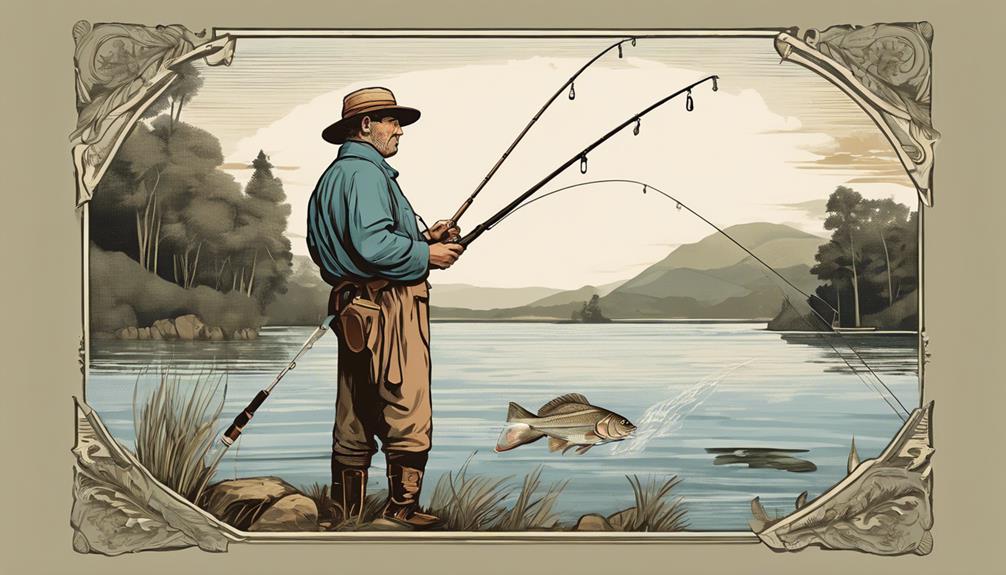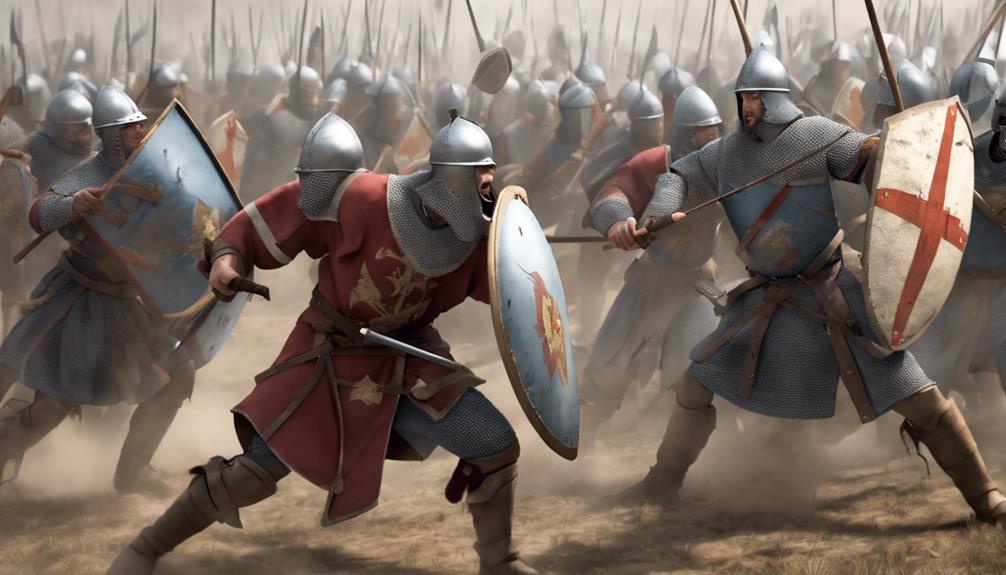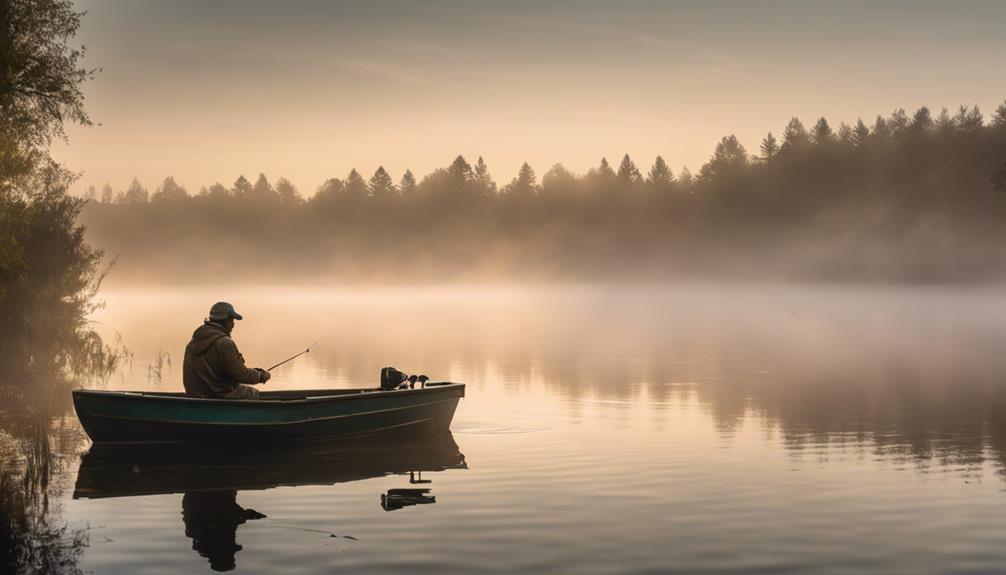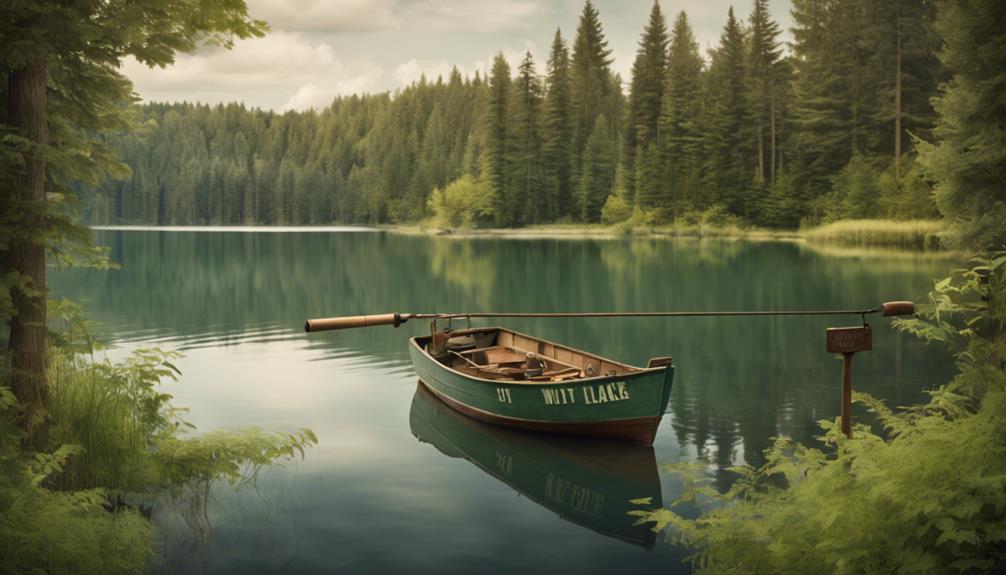As you navigate the vast waters of angling history, you'll find that significant milestones serve as markers along the riverbanks, guiding your understanding of the evolution of this beloved pastime.
From the early origins that can be likened to unraveling a mystery, to the modern innovations that shape the way we fish today, each step taken in the development of angling holds a story waiting to be uncovered.
From the humble beginnings to the present-day advancements, these historical milestones offer a glimpse into how angling has transformed over time, leaving you eager to discover the tales that lie beneath the surface.
Early Origins of Angling
Have you ever wondered how angling, a beloved pastime for many, first began? The early origins of angling date back to ancient times when fishing techniques were rudimentary yet effective. Fishing practices had significant historical significance as they provided a vital food source for communities and played a crucial role in their survival.
Ancient techniques for angling varied across different regions, with each culture developing its methods suited to the local environment. In Egypt, historical records show that angling was practiced along the Nile River using woven nets and traps to catch fish. Similarly, in ancient China, fishing techniques involved using silk lines and bamboo rods to lure fish. These early forms of angling laid the foundation for the more sophisticated methods we see today.
The historical significance of these early fishing practices can't be understated. They not only provided sustenance for communities but also led to the development of tools and techniques that are still used in angling today. As civilizations progressed, so did the art of angling, evolving into a recreational activity enjoyed by millions worldwide.
Development of Fishing Tackle
Exploring the evolution of fishing tackle reveals a fascinating journey of innovation and adaptation in angling equipment.
Here are three key points that highlight the significance of tackle evolution in enhancing fishing techniques and shaping angling history:
- Innovative Tackle Designs: Over the centuries, fishing tackle has evolved from simple handheld tools to intricate pieces of equipment designed for specific fishing techniques. The development of reels, rods, lines, and hooks has revolutionized the way anglers approach different types of fish and environments.
- Technological Advancements: The advancements in materials and manufacturing processes have greatly improved the durability and performance of fishing equipment. From the introduction of fiberglass rods to the use of carbon fiber and high-tech synthetic lines, anglers now have access to tools that were unimaginable in the early days of angling.
- Historical Impact: The evolution of fishing tackle parallels the growth of angling as a popular recreational activity and a competitive sport. The continuous refinement of gear hasn't only made fishing more accessible to a wider audience but has also contributed to the preservation of angling traditions and techniques passed down through generations.
Understanding the development of fishing tackle provides valuable insights into the rich tapestry of angling history and the enduring legacy of equipment advancements in the world of fishing.
Establishment of Angling Clubs
The evolution of fishing tackle paved the way for the establishment of angling clubs, marking a significant shift in the communal aspect of angling practices. Angling clubs began to emerge as a way for like-minded individuals to come together, share knowledge, and enjoy the sport in a structured setting. These clubs often set specific club regulations to ensure fair play, conservation of fish stocks, and the overall well-being of the angling community.
Joining an angling club came with various membership benefits. Members gained access to club-owned waters or exclusive fishing spots, which were often well maintained and stocked with fish. Additionally, being part of a club provided opportunities for socializing, networking, and participating in club events such as fishing competitions or educational workshops.
Club regulations typically included guidelines on catch limits, fishing methods, and conservation practices to ensure sustainable angling practices. These rules helped create a sense of responsibility among members towards the environment and the future of angling. Moreover, being part of an angling club allowed individuals to learn from experienced anglers, improve their skills, and contribute to the angling community as a whole.
Introduction of Fly Fishing Techniques
Introducing innovative fly fishing techniques revolutionized angling practices, elevating the art of fishing to new heights. Fly fishing isn't just about catching fish; it's a skillful and elegant form of angling that requires finesse and precision. Here's why the introduction of fly fishing techniques was a game-changer:
- Precision Fly Tying: Fly tying is an essential skill in fly fishing where anglers create artificial flies to mimic insects or baitfish. These flies are meticulously crafted using various materials like feathers, fur, and thread to attract fish in different conditions. The art of fly tying allows anglers to customize their flies to match the hatch, making it a crucial aspect of successful fly fishing.
- Masterful Casting Techniques: Unlike traditional bait casting, fly fishing relies on unique casting techniques that involve the weight of the fly line to propel the lightweight artificial fly. Anglers use techniques like the roll cast, false cast, and overhead cast to delicately present the fly to the fish. Mastering these casting techniques is fundamental to effectively placing the fly on the water with precision and accuracy.
- Immersive Experience: Fly fishing goes beyond simply catching fish; it's about connecting with nature and immersing yourself in the environment. The rhythmic motions of casting, the anticipation of a strike, and the challenge of landing a fish on a fly rod create a deeply rewarding and immersive experience for anglers. Fly fishing techniques have transformed angling into a captivating art form that continues to enchant fishing enthusiasts worldwide.
Invention of the Fishing Reel
With the invention of the fishing reel, anglers gained a crucial tool that revolutionized the way they could handle and control their fishing lines. The reel mechanics allowed for easier casting, line retrieval, and increased precision in bait presentation. Before the fishing reel, anglers had to manually manage their lines, which limited the distance and control they had over their casts. The introduction of the fishing reel marked a significant historical impact on angling practices.
The reel mechanics of the early fishing reels were simple, consisting of a spool that could be turned to wind or release the fishing line. Over time, advancements in reel design led to the development of more sophisticated mechanisms, such as baitcasting and spinning reels. These innovations improved the efficiency and effectiveness of fishing techniques, making it easier for anglers to target specific fish species and navigate different water conditions.
The historical impact of the fishing reel can't be overstated. It transformed angling from a rudimentary practice to a more refined and strategic sport. Anglers were now able to reach greater depths, cast with more accuracy, and battle larger fish with enhanced control. The invention of the fishing reel laid the foundation for modern angling practices and continues to be an essential tool for anglers worldwide.
Evolution of Sport Fishing Competitions
Sport fishing competitions have undergone a remarkable evolution in formats and scale over the years. Here are some key points to understand this evolution:
- Tournament Rules: The rules governing sport fishing competitions have become more standardized and sophisticated. From catch-and-release rules to strict size and weight requirements, these regulations ensure fair play and conservation efforts are upheld.
- Prize Money: The prize money in modern sport fishing competitions has significantly increased, attracting top anglers worldwide. This increase has elevated the status of these competitions and intensified the competitive spirit among participants.
- Competitive Strategies and Angler Skill: Anglers now employ advanced competitive strategies, leveraging technology and expertise to gain an edge over their rivals. The focus isn't only on catching the biggest fish but also on showcasing exceptional angling skills.
Sport fishing competitions today aren't just about landing a big catch but about demonstrating sportsmanship, strategic thinking, and mastery of the angling craft. As these competitions continue to evolve, anglers are constantly challenged to push the boundaries of their abilities while adhering to stringent tournament rules and aiming for lucrative prize winnings.
Creation of Conservation Organizations
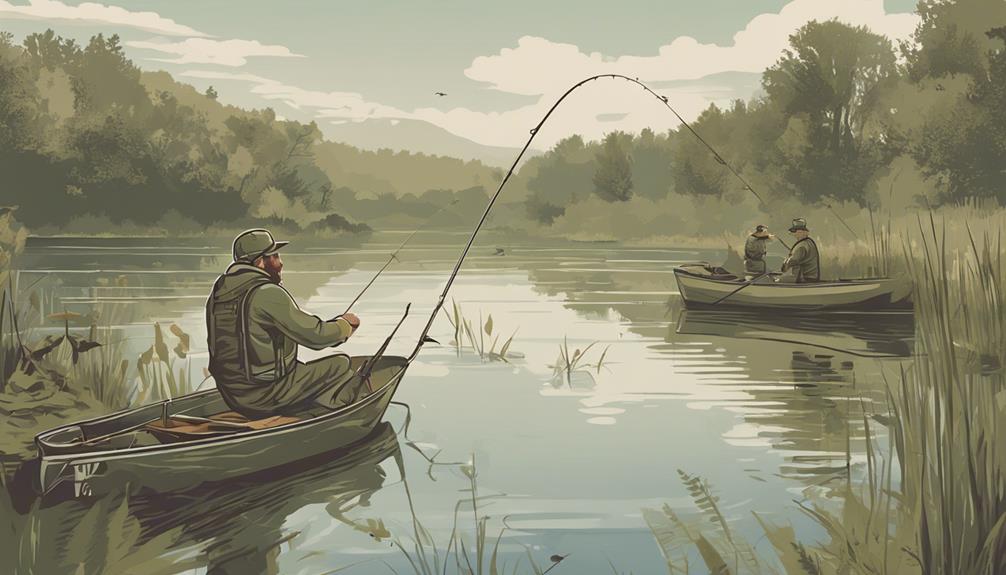
Conservation organizations emerged to safeguard the environment and protect aquatic ecosystems amidst the growing popularity of angling. These organizations focus on environmental stewardship and sustainability initiatives to ensure the long-term health of fish populations and their habitats. Through habitat restoration projects and wildlife conservation efforts, they strive to maintain the delicate balance of aquatic ecosystems, crucial for the survival of various species.
By actively engaging anglers, conservation organizations promote responsible fishing practices that help preserve natural resources for future generations. They educate the angling community on the importance of sustainable fishing methods, such as catch and release, to minimize the impact on fish populations and their habitats. Additionally, these organizations work towards creating marine protected areas and implementing regulations to prevent overfishing and habitat degradation.
Through collaborative efforts with government agencies, scientific researchers, and local communities, conservation organizations play a vital role in advocating for the protection of aquatic environments. By raising awareness about the interconnectedness of ecosystems and the significance of biodiversity, they highlight the importance of maintaining healthy fish populations for the overall well-being of the environment.
Modern Innovations in Angling Technology
Innovations in angling technology have revolutionized the way anglers approach fishing, enhancing efficiency and enjoyment on the water. Here are three key advancements that have transformed the angling experience:
- Smart Fishing Gadgets: The integration of smart technology into fishing gear has opened up a world of possibilities for anglers. From smart reels that track your casts and catches to underwater cameras that provide real-time footage of fish activity, these gadgets have taken fishing to a whole new level of precision and insight.
- Advanced Fish Finders: Modern fish finders use cutting-edge sonar technology to not only locate fish but also provide detailed information about the underwater terrain and vegetation. Anglers can now identify the best fishing spots with pinpoint accuracy, saving time and increasing their chances of a successful catch.
- Eco-Friendly Fishing Practices: With a growing emphasis on sustainability, anglers are increasingly turning to eco-friendly practices and sustainable bait options. Biodegradable baits, non-toxic lures, and catch-and-release techniques are becoming more popular, helping to preserve fish populations and protect the environment for future generations. By incorporating these practices into their angling routine, anglers can enjoy their sport responsibly while contributing to conservation efforts.
Frequently Asked Questions
How Did Angling Evolve and Spread to Different Regions Around the World?
Angling evolved over time due to cultural influences and technological advancements, gradually spreading globally. As societies interconnected, angling practices were shared and adapted, contributing to its globalization.
Different regions embraced angling for various purposes, such as sustenance, sport, or leisure, shaping local traditions and techniques. This evolution and exchange of angling knowledge continue to enrich the angling experience worldwide, reflecting a blend of cultural diversity and shared passion for fishing.
What Role Did Women Play in the History of Angling and How Has Their Participation Changed Over Time?
Women have always played a crucial role in angling, despite historical gender dynamics. Over time, their participation in fishing has evolved, breaking traditional barriers.
Initially, women's involvement was limited, but as society progressed, their presence in angling grew. Today, women are actively engaged in the sport, contributing to its diversity and richness.
Their influence continues to shape the angling community, driving inclusivity and equality in this beloved pastime.
What Are Some Lesser-Known Fishing Techniques or Customs That Have Influenced the Sport of Angling?
When it comes to traditional techniques and historical customs in angling, lesser-known practices can have a big impact. Cultural influences and innovations in angling can be found in various fishing methods and customs that have shaped the sport over time.
Exploring these unique approaches can offer new insights and appreciation for the diverse ways people have enjoyed fishing throughout history.
Can You Provide Examples of Famous Anglers Throughout History and Their Impact on the Sport?
Sure!
Throughout history, famous anglers like Dame Juliana Berners and Izaak Walton have made significant contributions to the sport. Their historical innovations and angler influence have shaped angling traditions for generations.
These individuals not only helped popularize fishing but also elevated it to a respected pastime with a cultural impact that endures today. Their passion for angling has inspired countless others to appreciate and participate in this beloved activity.
How Has the Perception of Angling Changed Over Time, Particularly in Terms of Environmental Conservation and Sustainability Efforts?
You've seen the perception of angling shift over time. Evolution in sustainability efforts has made a noticeable impact.
Anglers worldwide have embraced a more conservation-focused approach, recognizing the importance of protecting the environment. This shift has led to a global spread of sustainable angling practices, highlighting the connection between fishing and environmental stewardship.
As attitudes continue to change, the future of angling looks promising for both enthusiasts and the ecosystems they enjoy.
Conclusion
You've just learned about some of the significant historical milestones in angling. From the early origins of fishing to the development of modern angling technology, the sport has come a long way.
Angling clubs, fly fishing techniques, fishing reels, sport fishing competitions, and conservation organizations have all played a role in shaping angling into the popular recreational activity it is today.
Keep exploring and enjoying the world of fishing!
